Will NEXTDC’s A$6.4B Funding Make Australia the AI Data Center Capital of Asia-Pacific?
Inside NEXTDC’s record A$6.4B funding push and what it means for Australia’s bid to lead Asia-Pacific in sovereign AI and hyperscale data center infrastructure.
Welcome to Global Data Center Hub. Join investors, operators, and innovators reading to stay ahead of the latest trends in the data center sector in developed and emerging markets globally.
In August 2025, NEXTDC secured A$6.4 billion in debt facilities the largest in its history while maintaining pro forma liquidity of A$5.5 billion.
This isn’t just a capital raise. It’s a calculated move to lock in long-term financing for sovereign AI infrastructure across Asia-Pacific, at a moment when the AI buildout is accelerating and the cost of delay is measured in billions.
This kind of capital-first strategy parallels the financing shifts explored in Could Meta, PIMCO, and Blue Owl’s $29B Deal Be the New Blueprint for AI Data Center Financing?
Locking in Capital on Their Terms
NEXTDC has secured a new A$3.5B debt tranche, adding to its existing capacity:
Maturities: spread from 2029 to 2032.
Weighted average loan life: extended to 5.6 years.
Margins: lower than those achieved in the 2024 refinancing.
In a capital-intensive sector where interest rate volatility can derail multi-year projects, this structure gives NEXTDC predictability and flexibility.
The deal wasn’t built on a single bank relationship it was syndicated through major domestic and international lenders, signaling broad market confidence in NEXTDC’s strategy.
With long-dated capital secured, the company can advance multi-billion-dollar projects without being forced back into the market at inopportune times a critical advantage in an industry where timing is everything.
Demand That Justifies the Spend
The funding follows record contracted utilisation growth:
Q1 2025: added 52 MW a 30% increase bringing total contracted capacity to 228 MW.
Victoria: now at 161% of built capacity.
Kuala Lumpur facility: secured a 10 MW hyperscale customer before opening clear evidence of regional demand for high-performance, low-latency infrastructure.
This isn’t speculative building. The order book reflects committed hyperscale and AI deployments, driven by customers seeking sovereign-grade data residency, AI-ready density, and resilience against power or cooling bottlenecks.
The Sovereign AI Play
The centrepiece of NEXTDC’s expansion is the M4 Melbourne campus, a A$2B “AI Factory” designed for extreme performance:
Rack densities: over 1,000 kW.
Cooling: advanced liquid cooling systems.
Energy: on-site renewable generation and microgrids.
Efficiency: waste-heat recovery integration.
AI readiness: engineered for NVIDIA’s Blackwell and Rubin Ultra architectures.
Equally important, M4 meets government and defence-grade compliance standards.
In an era when AI sovereignty is shifting from policy talking point to procurement requirement, this compliance framework gives NEXTDC a defensible moat allowing hyperscalers to bring their most sensitive workloads into Australia with confidence in both performance and security.
Competitive Positioning in APAC
NEXTDC is not alone in chasing the region’s AI and hyperscale boom but few operators match its combination of:
Capital certainty.
Tier IV Gold operational sustainability.
Deep interconnectivity through a 770+ partner ecosystem.
This isn’t a generic colocation model. It’s a sovereign ecosystem built to serve as a secure hub for AI workloads in Australia and a gateway to Asia-Pacific.
Pairing Australian sovereign capability with selective overseas expansion into Malaysia, Japan, and New Zealand, positions NEXTDC to capture growth in multiple high-demand markets while keeping its home base as the anchor.
Regional expansion themes are also evident in Is Nvidia’s $2.36B Bet on Malaysia the Most Strategic AI Play in Southeast Asia?
Challenges Still in Play
Even with A$6.4B secured, NEXTDC faces significant constraints ahead:
Power grid upgrades: can take 4–8 years.
Water availability: increasingly politicized in high-demand regions.
Planning approvals: slow and unpredictable in some jurisdictions.
Export controls on advanced GPUs: could disrupt AI-ready capacity timelines.
NEXTDC is addressing these risks through site selection, renewable integration, recycled water cooling, and a focus on locations aligned with national and allied-nation security frameworks.
But in a market where demand is scaling rapidly, execution will require relentless management to stay ahead of shifting constraints.
The Bottom Line
NEXTDC isn’t simply adding megawatts. It’s building the sovereign AI infrastructure layer for the region, with financing structured to match the long timelines and technical complexity of that ambition.
For investors: the A$6.4B facility represents more than a balance sheet figure it’s a long-term growth position.
For policymakers: it’s a bet that Australia can anchor APAC’s AI infrastructure future.
And NEXTDC is positioning itself to be the one pouring the concrete.

